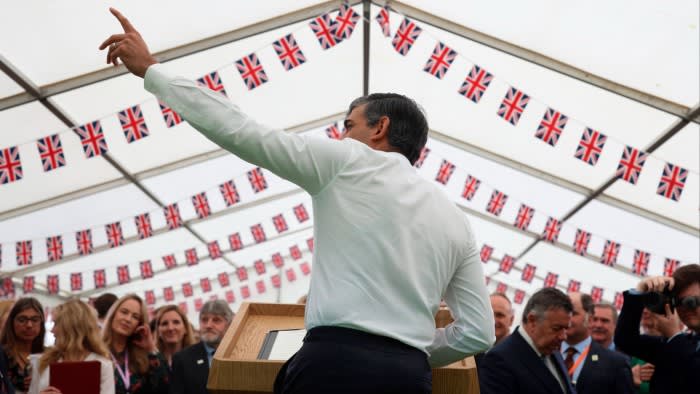These are bad times for conservatism’s self-image as the political tradition of good sense and stability. Britain’s exhausted Conservative party limps to defeat in the coming election under its fifth prime minister in just nine years. Its moderates have mostly fled or been driven out. Hard-right parties vie for primacy in Europe’s conservative mainstream. A convicted felon is on track to head the Republican ticket for president of the United States.
Conservatism’s image always had a strong element of myth. Since the late 19th century, when most conservatives made peace with modern life, they have held out a golden but conflicted promise: flourishing capitalism and social stability. Capitalism harnesses technological progress to generate and — if democratic — to spread wealth. In doing so, it forever turns society upside down. Conservatives, accordingly, must be skilful circus-riders, cantering the ring with one foot on a pony called “Capital” and the other on a pony called “Tradition”.
That two-pony conflict was understood by the shrewd, far-sighted American conservative Edward Luttwak when, 30 long years ago, he foresaw the rise of today’s hard right. His article in the London Review of Books was provocatively titled “Why fascism is the wave of the future”.
You can quarrel with the title as overblown or unhistorical, but Luttwak’s point was a good one. The typical conservative after-dinner speech, Luttwak wrote, was “a two-part affair, in which part one celebrates the virtues of unimpeded competition and dynamic structural change, while part two mourns the decline of the family and community ‘values’ that were eroded precisely by the forces commended in part one.” The question for today’s conservatives is if that double promise — be it delivered over a pay-for-a-chair dinner or to your phone — is still convincing.
Hard as it looks, it’s worth recalling how well in electoral terms conservatives have turned the trick. Take a small but salient core of big parties. Since the Federal Republic’s founding in 1949, Germany’s Christian Democrats have shared or held office for 52 of those 75 years. France’s presidents have been on the centre-right for 39 of the past 65 years — 46 if you include the ex-Socialist Emmanuel Macron. The right-left balance is more even in the US but in Britain, Conservative dominance is striking: in the past 110 years, the Tory party has held or shared office for 76 of them.
Doing that took skill and balance. Skills wear out, however. Runs come to an end. Some think that British conservatism as a centre-right tradition is already done for. Sir Oliver Letwin, a former Conservative minister and manifesto drafter, is convinced, as he has told me, “The party, as we’ve known it, is dead.” Not all Conservatives will agree with that, but something is happening to conservatism everywhere of which Britain’s Tories are an exemplary case.
A tradition of conflict

Generalising about conservatism is risky. A European tradition with old roots in reaction to capitalist modernity and its liberal champions long ago went global. Under the label or not, there are conservative parties in India, Brazil, Japan and South Korea, and many other multi-party democracies. Even if you strip conservatism to a representative foursome, different ways to vote and histories stand out.
Conservatives in Germany regularly govern with the left, where a mixed electoral system, written to avoid a re-collapse into extremism, encourages centrist coalitions. In France, which often changes its election rules, parties are fluid and frequently change name. Since the 1900s, the French parties of the mainstream right have used a mini-lexicon of permutational acronyms — UR, ARD, AD, RPF, RPR, CNI, UNR, UDR, UDF, UPR, UMP, LR — none of which contain the word “conservative”.
In the US and Britain, the first-past-the-post voting system favours two big parties that enjoy wide reach and long life at the price of endemic inner conflict. American Republicans have — or long had — left and right wings. Globalist Dwight D Eisenhower kept Robert Taft Sr’s Americanist Republicans in check. Liberal Nelson Rockefeller fell to anti-liberal Barry Goldwater. Richard Nixon held together Northern business and aggrieved white Southerners-turned-Republican. Since Ronald Reagan in the 1980s, the party has expunged its liberals and moved solidly and illiberally to the right.
For Britain’s Tories, infighting is a second name. The party’s Cain-and-Abel history is biblical: Robert Peel vs Benjamin Disraeli, Joseph Chamberlain vs Lord Salisbury, Edward Heath’s “Wets” vs Margaret Thatcher’s “Dries”, Europeans vs anti-Europeans. Its taste for self-slaughter makes its record in office the more remarkable. That continuity alone — and the oddly rare use of the label “conservative” itself — has always encouraged the thought that British conservatism was notably pure and exceptional. It wasn’t and isn’t. The party’s collapse towards the hard right reflects a general weakening of the centre across western democracies.
The hard right

To nail the type, the hard right is an unstable and uneven alliance of three tribes: free-market globalists, national welfarists and ethico-cultural traditionalists. Globalists want a small, nightwatchman state, with undemocratic freedom for foreign capital to come and go as it pleases. Welfarists want an effective state that cares for the national people and protects them from immigration. Globalists and welfarists disagree with each other on taxes, regulation and trade. They each combine smoothly enough with the traditionalists, whose sermons about moral decay and national decline they mimic or sit through out of tactical courtesy.
Holding the hard right together are two things: one real, the other a fantasy. The first is popular anger and disbelief at liberal democracy’s repeated failures to answer the insecurity and inequities brought about by massive structural changes from globalisation. Those are real enough.
The other is the hard right’s singling-out of a villain to blame for that discontent: a largely invented but rhetorically powerful enemy, the liberal elite. Hard-right globalists blame this omnicapable yet all-mistaken foe for the post-1945 ballooning of the state. Welfarists blame it for post-1990 undemocratic indifference to people and nation. Traditionalists blame it for post-1960s moral confusion, personal indiscipline and social decay.
A fair historical case can be made that 20th-century liberal democracy, when successful, owed its success in significant part to a complaisant, self-assured right — to liberal conservatives, that is, ready to compromise with leftwing liberals and progressives, so long as two things that conservatives treated as necessities — property and social stability — remained in dependably safe hands.
The hard right challenges liberal conservatism at its core — its refusal to treat the opposition as an enemy. The hard right, as the motley assortment of European parties shows, is not monolithic, it is true. For an obvious example, Marine Le Pen, who heads France’s National Rally, favours a Europe of hard-right nations. Giorgia Meloni, the Italian prime minister, wants a hard-right European Union. The failures to which the hard right responds are real enough. Its diagnosis — to blame a liberal enemy — is the political equivalent of a neurotic displacement.
After the day after

Once the results of Britain’s general election are known on July 5, Westminster insiders will offer microanalysis of where the Conservatives go now. Was defeat as bad as expected? Did Tories lose worse to hard-right Reform UK or to the Liberal Democrats? Will its own hard right prevail, under firebrand Suella Braverman or (more probably) Kemi (“I am certainly not an arsonist. I’m a Conservative”) Badenoch? Will the leftish (in Tory terms) Jeremy Hunt or a party middle-of-the-roader such as James Cleverly try to claim the wreckage?
All of that will matter — but not as much as what conservatism, if anything, now stands for. Conservatives after heavy defeat have faced that question before. Each time, they had a choice: copy their victors, embrace them and steal their clothes. Or resist them and before long crush them again. After 1945, the answer was copy, known as “Butskellism” (to be explained); after 1974, it was crush (Thatcherism); after 1997, copy (Cameronism). The trouble now is that Conservatives don’t seem to know whom to copy or what to crush.
After Labour’s 1945 postwar landslide, the Tories soon righted themselves. Besides retooling the party organisation and ballooning the membership, it invested in ideas at the Conservative Research Department under Rab Butler. Later in government Butler held all the great offices of state except prime minister. He was a liberal, social-minded Tory whose policies often converged with those of Labour’s Hugh Gaitskell, hence the label “Butskellism”. One such social-minded Tory said in self-mockery they were trying to make conservatism acceptable to Guardian readers.
Conservatives put their next time in the desert (1964-70; 1974-79) to use in creating Thatcherism. This was not copy, but crush. Its intellectual driver — from the Centre for Policy Studies — was Keith Joseph, a scholarly conservative with a gift of phrase who sat as a member of parliament (1956-87). Britain, he said, was “over-governed, overspent, overtaxed, overborrowed and over-manned”. His aptly titled book, Reversing the Trend (1975), played to a widespread belief among conservatives that Britain was on the road to perdition. Invoking the right’s classic theme of decline, Joseph knitted discrete problems — subsidised transport, public housing, single parents, management-union relations — into a compelling picture of a failed society awaiting rescue from inspiring new leadership.
By comparison, the Conservatives’ 13 years in the wilderness after defeat in 1997 was fallow time. The party chose to copy Tony Blair and New Labour, above all in its devotion to presentation and style. No compelling picture of conservatism emerged. Borrowing Stanley Baldwin’s all-purpose and under-informative label “one-nation conservatism”, Cameronism was thin on content. Add their 14 years in office, and for more than a quarter of a century Conservatives have left obscure what it is they stand for.
In search of ideas, Conservatives had, it is true, three handicaps. The first was a loss of geopolitical bearings after the end of the cold war, which the right shared with the left. That disadvantage is party-blind. Everyone is baffled. The second two, however, were distinctly Conservative. Thatcherism, love it or not, calcified into dogma, and the collective self-wounding of Brexit sucked time, thought and energy out of everything else in politics.
New thinking

This time may be different. Plenty of Tory brains are standing for parliament. They suggest intellectual renewal. But in what direction? They include Rupert Harrison, a former banker with an economics doctorate who in 2010-15 as George Osborne’s chief of staff was known at the Treasury as “the real chancellor”. He speaks for what the Bloomberg commentator Adrian Wooldridge has called “Notting Hill conservatism”. Britain’s future, on that view, lies in cosmopolitan cities, university towns and knowledge industries — and the Conservative’s future lies in appealing to voters there.
Nick Timothy, Theresa May’s ideas person in Downing Street, speaks by contrast for “Erdington conservatism” (after the district where he grew up in Birmingham, fief of the radical-turned-Conservative Unionist Joseph Chamberlain). Timothy speaks for a nation-minded welfarism. His book, Remaking One Nation (2020), well describes Britain’s public neglect and social disadvantage. Timothy has much policy advice and ideas for institutional changes to answer disaffection with government. The trouble is the demons. Liberals, for Timothy, are “tone deaf to voters, ignore community and short-change ‘love of Britishness’”.
The same fault can be found on the intellectual hard right in the US, to which British conservatives often look, not only from shared language and fellow feeling, but for money.
Patrick Deneen is a professor at the distinguished Catholic University of Notre Dame in Indiana and star of the American hard-right. In Regime Change (2023), he described his fellow Americans as downtrodden but voiceless. Yet for rescue from economic neglect and moral oppression, it is less voice they need in Deneen’s view than superior guidance by a virtuous, anti-liberal elite — a new politics he called, arrestingly, “aristopopulism”. Like Timothy, Deneen was full of policy ideas. Yet his loathing of liberals coloured the whole. At times, he sounded the troubled reformer proposing urgent repairs to a political society that is basically sound. At others, he came close to calling for an American theocracy.
Another eloquent hard-rightist in the US is Yoram Hazony. His Conservatism: A Rediscovery (2022) was not a policy book but a long essay that aimed to say what deeper public values conservatives stand for. What was the conservative’s sticking point where he or she says, “Yuck, this is wrong and cannot stand”? Hazony, an Israeli-American, is like Deneen, and unlike Timothy, not afraid of the soaring organ-stop and moral homily. (Timothy complains and blames, but that is different.)
Hazony is the brains behind National Conservatism, a small but vocal movement based in the well-funded Edmund Burke Foundation in Washington DC, which he chairs. It has international links in London, Brussels and Budapest, where national conservatism is a state-led project of the publicly endowed Mathias Corvinus Collegium, which promotes educational and anti-liberal causes. In May 2023, Hazony’s foundation ran a three-day conference in London, which drew stars of the British hard-right, including Suella Braverman and Miriam Cates, as well as much bien pensant mockery from right as well as left. Braverman wanted fewer liberals, Cates more babies. Laughter in response was too easy, however. Serious or not, voices of this kind need to be heard and answered.
Space left for liberal conservatives?

For a liberal, left or right, the silence of liberal conservatism ought to worry them. That is true not just in Britain but in the rest of Europe and the US. Where are the speechwriters of the liberal right making sense of such turmoil, telling a convincing historic story of where we should be headed and what strategy would help us get there? They are there. They know the common liberal values they should be speaking for. Yet they have been silenced by the voices and vigour of the hard right.
No convincing narrative with rhetorical appeal is on offer either from an equally confused and silent liberal left. Well-identified problems and intelligent offers for their solution abound in a troubled liberal world but defences of that world itself and its values are barely heard. They are spoken for in well-hewn essays, yes, but not crowed and shouted as they ought to be.
Into that silence has burst the seductive, angry music of a hard right. The future health of conservatism in any historically recognisable form will depend a lot on whether or not there remains a strong voice in politics for liberal conservatives — the kind who do not need enemies.
Edmund Fawcett is the author of ‘Conservatism: The Fight for a Tradition’ (Princeton University Press)
Find out about our latest stories first — follow FT Weekend on Instagram and X, and subscribe to our podcast Life & Art wherever you listen



